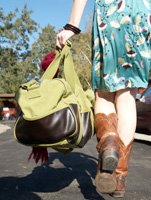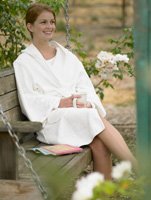Organic Style
Bay Area Internet retailer finds niche in green lifestyle
Gerald Prolman’s business is blossoming, but it hasn’t been a dainty, delicate type of bloom. It has been more like “Jack and the Beanstalk,” in which magic seeds sprout a growth that stretches into the clouds. This year, Prolman expects to do 10 times the business he did last year, making for a lucrative harvest.
Originally planted in 2001 as online florist Organic Bouquet (www.organicbouquet.com), Prolman’s company grew slowly but steadily for seven years before being reborn as Organic Style (www.organicstyle.com) last November.
Incorporated in England but headquartered in San Rafael, Calif., about 12 miles north of the Golden Gate Bridge, the company now offers a full range of organic and fair-trade lifestyle products, including a growing apparel line designed by fashion-industry veterans.
California Apparel News spoke with Prolman, who spent 30 years in the natural-foods sector before founding Organic Style, about “eco-chic apparel” and running a socially responsible business.
CAN: Tell us how your company evolved into Organic Style.GP: We realized our customers wanted to buy more from us than just flowers. We started marketing gourmet gift baskets and gardening gifts, but our consumers were asking for eco-chic apparel. So, last year, we launched a plan to expand into other categories.
Organic Style was a magazine put out in 2001 by Rodale Inc. [Prevention, Men’s Health] to show that organic products could be stylish. It was pulled in 2005 because they couldn’t cross over with advertising. But, six months later, every fashion magazine had a green issue, so they pulled it a little too early, before eco took off.
It was a dormant brand, so I made an offer to purchase it as a top company. We established it in the United Kingdom as Organic Style Ltd. because we’re building an international e-commerce business. CAN: Who’s behind your apparel collection?GP: A year ago we put together a very sophisticated group of seasoned apparel industry workers. We have staff with experience at Esprit, Adrienne Vittadini, Jessica McClintock, Cole Haan and Gucci. And the chairman of our company, Adrien Bellamy, is on the board of the Gap. CAN: So you have a house brand?GP: Yes, that’s what they work on. We have our own brand, but we also feature young, up-and-coming designers. What we’re really focused on is “loungerie”: comfortable clothes for home that you can also wear outside. But we also carry yoga apparel, sleepwear, sportswear and dresses. Our house brand is only available at Organic Style, and we try to get as many exclusive items as possible and interesting accessories. And everything comes from socially and environmentally responsible sources.CAN: Explain what that means.GP: It means employees in the factories are paid a livable wage and are provided safe working conditions and that the Earth is not contaminated in the process. Our clothes are certified organic under U.S. FDA regulations or are fair-trade certified—and sometimes both. And it’s quality and luxury at the same time. CAN: You just launched in November. How was your Christmas, as far as sales go?GP: It was incredible. We exceeded expectations. Just coming right out of the gate, people were shopping. CAN: How did you promote the site?GP: We initially made an announcement to our large customer base of floral customers. It’s growing exponentially, but right now we have 70,000 people in our database.
We just re-launched Organic Style as an online magazine and got 10,000 new e-mail addresses in the last 30 days.
In the magazine, you get to meet the cotton growers and go to the mill where your bathrobe was made. You see firsthand the person who grew the cotton you’re wearing. And this is what you’re supporting when you buy these products, and it’s making a positive difference in the world.
After Mother’s Day, we’re launching a Web 2.0 strategy where you can actually meet the growers and artisans on the Web site.CAN: Can you give us an example of who these people are, tracing the line from grower to end user?GP: It’s really a beautiful story. For example, we have an arrangement with a company called Coyuchi, which designs products and has them made in India. So let’s say you get a nightgown that comes from Coyuchi, which contracts with a mill in Calcutta that’s dually certified as organic and fair trade. They have a partnership with a grower group, in which each grower typically has only one acre, but, combined, they produce 300 tons of cotton.
Cotton is one of the most chemical-intensive crops in the world. And there is a real problem with grower suicides in India. There’s so much price pressure on the growers, who face pests and other problems. They have to use genetically altered seeds and buy expensive chemicals and go into debt. At the end of the season, if there was [too much] rain, crop failure, low yield or the market is weak, they don’t have enough money to pay their bills, and out of desperation they kill themselves. This is happening in increasing numbers in India.
What we’ve done is go organic and fair trade, so we pay the growers a proper price so they can have a livable wage. It’s nickels and dimes, but we make absolutely sure it goes in the pockets of those growers. CAN: How much does this affect the retail price?GP: We’re priced competitively, so you don’t have to pay more, and we do that through the way in which we market. We’re not asking our customers for a premium; we’ve just figured out how to market efficiently so we can afford to pay the right price to our growers so they cannot just survive but thrive.
We’re talking pennies, but to a grower it can mean double or more. People don’t realize how little the person on the production end gets. The people who do the most amount of work get paid the least amount of money because there’s constant pressure to squeeze every last penny out of them.
And, if people knew what was really behind the clothes they wear, they wouldn’t be so comfortable wearing them. CAN: And you believe we’re at the dawn of an awakening, when people are really starting to care about these things. GP: Awareness is at an all-time high. Responsible purchasing is a growing thing that’s changing the market landscape. There are 35 million educated and affluent consumers spending more than $209 billion on socially and environmentally responsible products. CAN: What are your first-year sales projections? GP: We’re a privately held company, so we don’t reveal sales information. CAN: What is Organic Style’s growth rate? GP: We’re growing through internal growth as well as acquisitions, so we’re going to grow more than 10 times from 2007 to 2008.CAN: And you’re referring to sales growth, so if sales were $1 million last year they’ll be $10 million this year?GP: Right, but we’ll be higher than that. CAN: You’ve used the term “eco luxury,” and you’re headquartered in Marin County, one of the most affluent areas in the world. Your company message is certainly a noble one, but how do you allow the masses to participate in socially and environmentally responsible consuming?GP: Our prices range from $29 to $149, and our sweet spot is under $50. So it’s very affordable; it’s a very easy decision for people to make. You’re going to pay a reasonable price and know that the person who made it was paid a reasonable price. CAN: How do you keep prices down—by cutting out the middleman?GP: Exactly, and, in many cases, there’s not even a wholesaler; we’re dealing directly with the farmer. And not just for flowers but [for] some apparel, as well.
But it’s really the way we market. We have partnerships with 45 charitable organizations, and they market our goods to their membership bases. So we make a donation as a portion of any sale.
We’re creating an article of clothing that you’re going to feel so good about because there’s this incredible story—from the farmer, how it was made [and] what it’s packed in to a donation that was made to a charity—and it’s all goodness at every step of the way.
These partnerships give us access to more than 10 million consumers who passionately care about the environment, social justice and animal welfare. It’s a very targeted group of people interested in the products we have, and it makes our customer-acquisition cost very low.
























